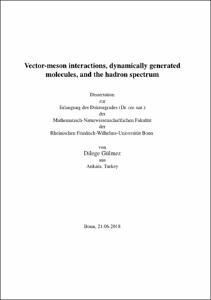Vector-meson interactions, dynamically generated molecules, and the hadron spectrum

Vector-meson interactions, dynamically generated molecules, and the hadron spectrum

| dc.contributor.advisor | Meißner, Ulf-G. | |
| dc.contributor.author | Gülmez, Dilege | |
| dc.date.accessioned | 2020-04-25T10:51:59Z | |
| dc.date.available | 2020-04-25T10:51:59Z | |
| dc.date.issued | 19.09.2018 | |
| dc.identifier.uri | https://hdl.handle.net/20.500.11811/7621 | |
| dc.description.abstract | We study the lowest-lying vector-meson interactions and dynamically generated bound states. Therefore, these bound states are studied as hadronic molecules. We demonstrate that some unitarization methods are not well-defined to study the pole structures of amplitudes in the region far from the threshold. We employ an improved unitarization method based on a covariant formalization that is necessary to study the pole structures of amplitudes in the region far from the threshold. In this work, first, we study the analysis of the covariant ρρ scattering in a unitarized chiral theory and then extend it to the strange sector, i.e. SU(3) chiral symmetry. We demonstrate that the on-shell factorization of the Bethe-Salpeter equation is not suitable away from the threshold. Moreover, the left-hand cuts would overlap the right-hand cuts for the coupled-channel unitarization of the Bethe-Salpeter equation. It makes unitarized amplitudes non-analytical and the poles of amplitudes, associated to possible bound states or resonances, unreliable. To avoid this difficulty, we employ the first iterated solution of the N/D method and investigate the possible dynamically generated resonances and bound states. A comparison with the non-relativistic calculation is provided as well. | |
| dc.language.iso | eng | |
| dc.rights | In Copyright | |
| dc.rights.uri | http://rightsstatements.org/vocab/InC/1.0/ | |
| dc.subject.ddc | 530 Physik | |
| dc.title | Vector-meson interactions, dynamically generated molecules, and the hadron spectrum | |
| dc.type | Dissertation oder Habilitation | |
| dc.publisher.name | Universitäts- und Landesbibliothek Bonn | |
| dc.publisher.location | Bonn | |
| dc.rights.accessRights | openAccess | |
| dc.identifier.urn | https://nbn-resolving.org/urn:nbn:de:hbz:5n-51719 | |
| ulbbn.pubtype | Erstveröffentlichung | |
| ulbbnediss.affiliation.name | Rheinische Friedrich-Wilhelms-Universität Bonn | |
| ulbbnediss.affiliation.location | Bonn | |
| ulbbnediss.thesis.level | Dissertation | |
| ulbbnediss.dissID | 5171 | |
| ulbbnediss.date.accepted | 27.07.2018 | |
| ulbbnediss.institute | Mathematisch-Naturwissenschaftliche Fakultät : Fachgruppe Physik/Astronomie / Helmholtz-Institut für Strahlen- und Kernphysik (HISKP) | |
| ulbbnediss.fakultaet | Mathematisch-Naturwissenschaftliche Fakultät | |
| dc.contributor.coReferee | Hanhart, Cristoph |
Files in this item
This item appears in the following Collection(s)
-
E-Dissertationen (4115)




